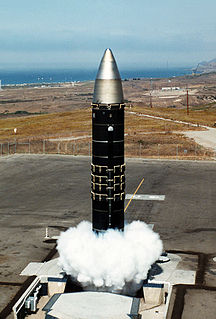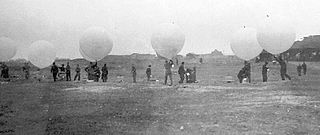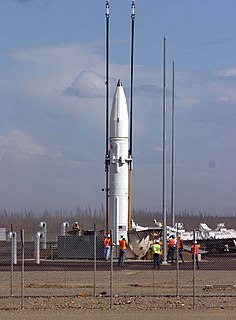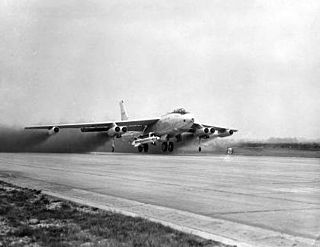Related Research Articles

A cruise missile is a guided missile used against terrestrial or naval targets that remains in the atmosphere and flies the major portion of its flight path at approximately constant speed. Cruise missiles are designed to deliver a large warhead over long distances with high precision. Modern cruise missiles are capable of travelling at high subsonic, supersonic, or hypersonic speeds, are self-navigating, and are able to fly on a non-ballistic, extremely low-altitude trajectory.

The LGM-118 Peacekeeper, originally known as the MX for "Missile, Experimental", was a MIRV-capable intercontinental ballistic missile (ICBM) produced and deployed by the United States from 1985 to 2005. The missile could carry up to twelve Mark 21 reentry vehicles, each armed with a 300-kiloton W87 warhead. Initial plans called for building and deploying 100 MX ICBMs, but budgetary concerns eliminated the final procurement; only 50 entered service. Disarmament treaties signed after the Peacekeeper's development led to its withdrawal from service in 2005.

The British Aircraft Corporation TSR-2 is a cancelled Cold War strike and reconnaissance aircraft developed by the British Aircraft Corporation (BAC), for the Royal Air Force (RAF) in the late 1950s and early 1960s. The TSR-2 was designed around both conventional and nuclear weapons delivery: it was to penetrate well-defended frontline areas at low altitudes and very high speeds, and then attack high-value targets in rear areas. Another intended combat role was to provide high-altitude, high-speed stand-off, side-looking radar and photographic imagery and signals intelligence, aerial reconnaissance. Only one airframe flew and test flights and weight-rise during design indicated that the aircraft would be unable to meet its original stringent design specifications. The design specifications were reduced as the result of flight testing.

The Convair B-36 "Peacemaker" is a strategic bomber that was built by Convair and operated by the United States Air Force (USAF) from 1949 to 1959. The B-36 is the largest mass-produced piston-engined aircraft ever built. It had the longest wingspan of any combat aircraft ever built, at 230 ft (70 m). The B-36 was the first bomber capable of delivering any of the nuclear weapons in the U.S. arsenal from inside its four bomb bays without aircraft modifications. With a range of 10,000 mi (16,000 km) and a maximum payload of 87,200 lb (39,600 kg), the B-36 was capable of intercontinental flight without refuelling.

The AGM-86 ALCM is an American subsonic air-launched cruise missile (ALCM) built by Boeing and operated by the United States Air Force. This missile was developed to increase the effectiveness and survivability of the Boeing B-52H Stratofortress strategic bomber. The missile dilutes an enemy's forces and complicates air defense of its territory.

Operation Outward was a British campaign of the Second World War that attacked Germany and German-occupied Europe with free-flying balloons. It made use of cheap, simple balloons filled with hydrogen and carrying either a trailing steel wire to damage high voltage power lines by producing a short circuit, or incendiary devices to start fires in fields, forests and heathland. A total of 99,142 Outward balloons were launched; about half carried incendiaries and half carried trailing wires.

The militarisation of space involves the placement and development of weaponry and military technology in outer space. The early exploration of space in the mid-20th century had, in part, a military motivation, as the United States and the Soviet Union used it as an opportunity to demonstrate ballistic-missile technology and other technologies having the potential for military application. Outer space has since been used as an operating location for military spacecraft such as imaging and communications satellites, and some ballistic missiles pass through outer space during their flight. As of 2018, known deployments of weapons stationed in space include only the Almaz space-station armament and pistols such as the TP-82 Cosmonaut survival pistol.

Nuclear weapons delivery is the technology and systems used to place a nuclear weapon at the position of detonation, on or near its target. Several methods have been developed to carry out this task.

The Ryan Model 147 Lightning Bug is a jet-powered drone, or unmanned aerial vehicle, produced and developed by Ryan Aeronautical from the earlier Ryan Firebee target drone series.

Agni-II, is the second strategic ballistic missile of Agni (missile) family envisaged to be the mainstay of the Indian missile-based strategic nuclear deterrence. The Agni-II is a medium-range ballistic missile (MRBM) with two solid fuel stages and a Post Boost Vehicle (PBV) integrated into the missile's Re-entry Vehicle (RV). The Agni's manoeuvring RV is made of a carbon-carbon composite material that is light and able to sustain high thermal stresses of re-entry, in a variety of trajectories. The Agni-IIA is a more advanced version of Agni-II, albeit with more sophisticated and lighter materials, yielding a better range and operating regime. Agni-IIA was later renamed as Agni-IV plugging the gap between Agni-II and Agni-III. While the first test of Agni-IV in December 2010 was a failure, the second test flight in November 2011 was a success Agni-II, developed as part of medium- and long-range Agni series of missile systems, has already been inducted into the Armed Forces.
Project 119L was a Cold War reconnaissance operation by the U.S. Air Force in which large espionage balloons floated cameras over the Soviet Union.

Project Kingfisher was a weapons-development program initiated by the United States Navy during the latter part of World War II. Intended to provide aircraft and surface ships with the ability to deliver torpedoes to targets from outside the range of defensive armament, six different missile concepts were developed; four were selected for full development programs, but only one reached operational service.

The GAM-63 RASCAL was a supersonic air-to-surface missile that was developed by the Bell Aircraft Company. The RASCAL was the United States Air Force's first nuclear armed standoff missile. The RASCAL was initially designated the ASM-A-2, then re-designated the B-63 in 1951 and finally re-designated the GAM-63 in 1955. The name RASCAL was the acronym for RAdar SCAnning Link, the missile's guidance system. The RASCAL project was cancelled in September 1958.

The Bold Orion missile, also known as Weapons System 199B (WS-199B), was a prototype air-launched ballistic missile (ALBM) developed by Martin Aircraft during the 1950s. Developed in both one- and two-stage designs, the missile was moderately successful in testing, and helped pave the way for development of the GAM-87 Skybolt ALBM. In addition, the Bold Orion was used in early anti-satellite weapons testing, performing the first interception of a satellite by a missile.

The High Virgo, also known as Weapons System 199C (WS-199C), was a prototype air-launched ballistic missile (ALBM) jointly developed by Lockheed and the Convair division of General Dynamics during the late 1950s. The missile proved moderately successful and aided in the development of the later GAM-87 Skybolt ALBM. It was also used in early tests of anti-satellite weapons.

Weapons System 199 (WS-199) was a weapons development program conducted by the United States Air Force to research and develop new strategic weapons systems for Strategic Air Command. Two air-launched and one ground-launched vehicles were developed as part of the program. While none entered production, they assisted in the development of both the GAM-87 Skybolt air-launched ballistic missile and that of re-entry vehicles for ballistic missiles.

The ASM-A-1 Tarzon, also known as VB-13, was a guided bomb developed by the United States Army Air Forces during the late 1940s. Mating the guidance system of the earlier Razon radio-controlled weapon with a British Tallboy 12,000-pound (5,400 kg) bomb, the ASM-A-1 saw brief operational service in the Korean War before being withdrawn from service in 1951.

The GT-1 was an early form of stand-off weaponry developed by the United States Army Air Forces during World War II. Intended to deliver an aerial torpedo at a safe range from the launching aircraft, the weapon proved successful enough in testing to be approved for operational use, and the GT-1 saw limited use in the closing stages of the war.
Television guidance (TGM) is a type of missile guidance system using a television camera in the missile or glide bomb that sends its signal back to the launch platform. There, a weapons officer or bomb aimer watches the image on a television screen and sends corrections to the missile, typically over a radio control link. Television guidance is not a seeker because it is not automated, although semi-automated systems with autopilots to smooth out the motion are known. They should not be confused with contrast seekers, which also use a television camera but are true automated seeker systems.

An incendiary balloon is a balloon inflated with a lighter-than-air gas such as hot air, hydrogen, or helium, that has a bomb, incendiary device, or Molotov cocktail attached. The balloon is carried by the prevailing winds to the target area, where it falls or releases its payload.
References
Citations
Bibliography
- Christopher, John (2004). Balloons at War: Gasbags, Flying Bombs and Cold War Secrets. Stroud, England: Tempus Publishing. ISBN 978-0-7524-2995-3.
- Parsch, Andreas (21 March 2006). "WS-124A Flying Cloud". Directory of U.S. Military Rockets and Missiles, Appendix 4: Undesignated Vehicles. Designation-Systems. Retrieved 2017-12-10.
- Peebles, Curtis. The Moby Dick Project: Reconnaissance Balloons Over Russia. Washington, DC: Smithsonian Institution Press. ISBN 978-1-5609-8025-4.